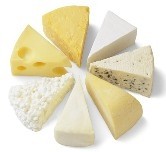Chr. Hansen promises bigger holes in Swiss cheese with new cheese culture

Citing growing demand for sliced cheese products – Swiss cheese types such as Maasdammer and Emmenthal – Chr. Hansen marketing manager for cheese cultures, Anne-Claire Bauquis told DairyReporter.com:
“The demand for sliced Swiss cheese is a trend we see in the US and in many European countries: Poland and Eastern countries but also Germany, The Netherlands and Belgium. It is linked to snacking and consumption for breakfast.”
Swiss cheese makers must ensure fast and controlled eye (hole) formation, Chr. Hansen said, while consumers preferred a distinctive nutty flavour together with a sweet mouthfeel.
Launched in response to these trends, Chr. Hansen’s trademarked Open IT PS-60 was able to control and standardise the fermentation process, the company said. Touted benefits included high and fast gas formation (meaning a short ripening time) and a well-balanced, sweet, nutty flavour with low pungency due to low lipolytic activity.
Successful consumer trials
Bauquis said the above properties had been confirmed in consumer trials, and she said that the culture was also cost-efficient due to its high concentration and high activity per cell, with one 500-unit frozen format carton normally sufficient to inoculate 10,000-15,000 litres of milk, and eye formation effective after 14-20 days depending on ripening conditions.
According to Bauquis, PS-60 was a fast lactate fermenting culture, robust to different ripening parameters. "Good growth is recorded even in difficult conditions, at low temperature as well as in high salt or low pH environments,” she said.
Asked to quantify some of the claimed benefits, and why Chr. Hansen's customers should prefer PS-60 to standard Propionic Shermanii cultures, Bauquis told this publication:
"The fatty acid content in cheese is reduced by 30% compared to PS-4, so far the best seller in our range. The flavor was found statistically less soapy and pungent than the Propionic cultures that we have tested tested in the same conditions and at the same level of inoculation.
"The level of free amino acids released in cheese was also slightly reduced compared to other cultures tested. The flavour intensity was typical of a Swiss/Maasdamm cheese but the intensity was significantly milder," she added.
Faster eye formation
Speed of eye formation was first evaluated in a warm room, by observing the increase of volume each week, Bauquis said, with suitable volumes reached about one week ahead with PS-60, compared to PS-4.
"Besides, at the same stage , the number of eyes and the size of eyes obtained with PS-60 are higher and bigger respectively, in comparison to PS-4," she added.
Quizzed about how long it took to develop such a culture and key production challenges, Bauquis said: "It took two years from the beginning of the screening to the launch. After the characterisation steps, a very extensive number of validations were achieved on pilot plant cheeses.
"Many processing conditions were tested and many comparisons were done to other strains from our range and competitive cultures. For example, lactate fermentation, succinate level, lipolysis, proteolysis, amino acids release, observation of eye formation and sensory evaluation by cheese profiling."






























